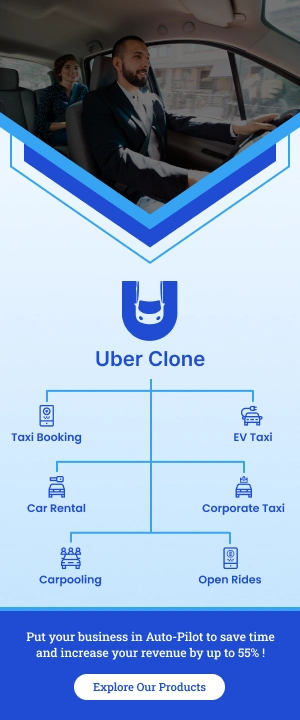
The first generation of ride-hailing apps brought in a significant change in the conventional taxi dispatching system. Companies such as Uber and Lyft changed the market with the help of GPS-based tracking, online payments, and easy matching of drivers and passengers.
Creating a ride-hailing app similar to Uber is no small feat. Whether you’re a startup entrepreneur or a business looking to expand into the ride-hailing market, following a structured approach in your app development process is essential.
In this guide, we’ll explore the key stages in Uber clone app development and the ride-hailing app lifecycle, helping you understand the steps to take from concept to launch.
What is an Uber Clone App?
An Uber clone app is a ready-made ride-hailing solution that copies the functionality of Uber. It allows companies to run their branded ride-sharing service without the need to create a new app. These solutions are also customizable
The development of an Uber clone app will help businesses streamline operations by automating ride bookings, optimizing driver allocation, and reducing manual intervention. This ensures a seamless and efficient ride booking experience for users, improving both customer satisfaction and operational efficiency.
The Best Must-Have Features of a Successful Uber Clone App
To have a successful ride-hailing app lifecycle and Uber clone app, you must consider these features-
Easy Login & Registration
A smooth signup procedure guarantees the ease of use through email, phone number, or social media. The provision of OTP-based verification will be more secure and convenient for logging in.
Moreover, the possibility to store profiles, preferred payment methods, and ride preferences enhances convenience, and the onboarding process becomes easy and convenient.
Real-Time Ride Tracking
Live GPS tracking allows users to know about their ride progress, including the arrival of a driver and route navigation. This aspect increases safety, transparency, and convenience due to real-time updates of passengers.
To the drivers, it helps in the best route planning, eliminating the wastage of time. This feature can also be used by businesses to monitor the status of their fleets and improve their operations.
Various Payment Methods
The provision of a variety of payment options, including credit/debit cards, digital wallets, UPI, and cash, increases the convenience of users. Safe and secure payment gateways maintain a smooth flow of transactions. It is more flexible, as it is integrated with popular e-wallets that suit the preferences of various users.
Moreover, automated fares will be calculated, which will eliminate disagreements between the passengers and the drivers.
Ride Scheduling
The capability of scheduling rides in advance provides an additional convenience to users who schedule their rides in advance. This characteristic is necessary for airport transfers, business travel, and rush-hour rides.
Riders receive ride reminders, while drivers can optimize their schedules. Pre-scheduling also allows businesses to anticipate demand patterns, ensuring more rides are available and services are effectively managed.
Surge Pricing and Fare Estimation
It also has an inbuilt fare calculator that gives an estimated cost of the ride before booking a ride. This aspect contributes to transparency, which assists the passengers in planning their journeys.
Additionally, surge pricing is used to guarantee availability at peak hours by encouraging drivers. Intelligent algorithms can set fares as per demand, traffic, and distance of the ride, and maximize profitability without compromising on the efficiency of the service.
Driver and Rider Rating System
The ratings by the user and the driver improve the quality of services through accountability. Both parties will be able to leave feedback after every ride, depending on the experience.
Good drivers gain credibility, and the bad performers can be flagged. This system can generate trust, enhance customer satisfaction, and enable businesses to uphold high standards of service.
Push Notifications & Alerts
Users are updated about the status of the rides, arrival of the drivers, payment confirmation, and promotional offers promptly. Passengers are also reminded of scheduled rides through push notifications.
On the part of drivers, ride request alerts and route change alerts enhance efficiency in operations. This aspect increases the level of interaction, and the users remain attached to the app’s services.
Ride-Sharing and Pooling
Carpooling options enable several passengers to share a ride and save money, and have a positive impact on the environment. This is better for users seeking affordable transport and helps drivers maximize their income.
Intelligent algorithms pair passengers with similar routes, so they have to take minimal detours. Ride-sharing also decreases traffic jams and carbon footprint, which is in line with the trends of sustainable mobility.
Admin Dashboard and Analytics
An effective admin panel gives information about ride statistics, revenue reports, driver performance, and customer feedback. Real-time analytics can be used to optimize pricing, fleet management, and service quality.
Features like heatmaps highlight areas of high demand, enabling better resource allocation. With detailed data analysis, businesses can make informed decisions and improve their overall performance.
In-App Chat and Support
It has an in-built messaging system that allows riders and drivers to communicate easily. The app allows users to explain pickup points, approximate arrival times, or any other issues directly in the app.
Moreover, 24/7 customer support through chatbots or live agents will provide a fast solution to any problem. Provision of multilingual support increases accessibility, supporting a variety of user demographics and increasing overall user satisfaction.
Get Investory-Ready Instantly. Our Uber Clone will Help You Launch Your Taxi Booking App That Investors Feel Confident About.
Key Stages in Uber Clone App Development
The ride-hailing services market is projected to grow by USD 102.18 billion between 2024 and 2029, registering a compound annual growth rate (CAGR) of 16.1% during this period. Here is what the ride-hailing app lifecycle looks like
Stage 1: Market Research and Analysis
All Uber clone apps that have become successful begin with market research and analysis. It is essential to learn your target audience, local market needs, and competitor strategies before you start the development process. By studying the latest developments in the ride-hailing market, you will be able to find the unique selling points (USPs) that will make your app stand out.
It is also essential to carry out a competitive analysis. Research about Uber, Lyft, and other competitors in the area to learn about their characteristics, pricing structure, and business plans. This information will assist you in making informed choices during the development process.
Step 2: App Features and Functionality Definition
After collecting all the required insights, you will be able to start defining the main features and functionality of both riders and drivers. The key rider features are real-time tracking of their ride, the ability to pay, and a ride history feature. Instead, drivers need an unobstructed interface to accept and navigate rides and monitor earnings.
Also, you may not miss the admin panel where the administrators can manage the users, track the ride activity, and process payments.
Stage 3: UI/UX Design and Prototyping
The third step is to make a user-friendly design, which is also appealing to the eye. The UI/UX design is an important aspect of Uber clone app development since a positive user interface (UI) and a pleasant user experience (UX) keep the customers interested. The design must make the booking process as easy as possible for the riders and drivers, and minimize the steps.
It is also significant to have prototyping and wireframing at this stage. The prototyping will assist you in visualizing the working of the app, ensuring the user interface meets user expectations. This is the stage when you start testing and fine-tuning the design aspects, and then proceed with the development.
Stage 4: Backend Development and App Architecture
It is at the backend development stage that the magic occurs. This includes the selection of the appropriate technology stack for the app architecture. You will have to develop a scalable system capable of supporting thousands of concurrent users.
In addition, third-party APIs, such as Google Maps, to provide navigation, and payment systems used to make financial transactions, must be integrated. Ensure your backend is well secured to safeguard user information and payment details.
Stage 5: Android and iOS App Development
With the backend ready, it is time to build the mobile app. Based on your budget and the intended audience, you can either build a native app (on both Android and iOS) or a cross-platform app using a framework such as React Native or Flutter.
Native apps are more efficient and have a better user experience, whereas cross-platform apps are faster to develop and maintain. Ensure that the app is optimized for both Android and iOS platforms to increase its user base.
Stage 6: Testing & Quality Assurance
One of the most important stages of the ride-hailing app lifecycle is testing. At this point, you will be keen to carry out different forms of tests to ascertain that your app is working according to plan. Functional testing is done to make sure that every feature of the app is functioning as expected. In contrast, usability testing is done to ensure that the user can easily use the app.
Another important aspect is security testing, particularly when you are processing payments. Ensure that user data and payment information are secure against possible threats.
Stage 7: Deployment and Launch
After all the testing stages of your app are over, it is time to launch. This entails posting the app in the Google Play Store as well as the Apple App Store. You should also develop a marketing plan, which involves app store optimization (ASO) to help users discover your app.
Once you launch, it is important to monitor the app’s performance, address any problems, and update it regularly.
Addressing Challenges in Uber Clone App Development
It’s important to address key challenges in the Uber clone development stages. Here is how-
Scaling and Server Load Control
When your app is growing, it is important to ensure that it can support growing traffic. Choose cloud-based infrastructure such as AWS or Google Cloud to scale your app easily and efficiently handle server loads.
Legal and Regulatory Compliance
As Uber is active in several countries and regions, various legal requirements must be followed. It is important to know the tax laws, the insurance policy, and other legal provisions of running a ride-hailing business.
Choosing the Right Uber Clone App Development Company
By working with an experienced Uber clone app development company, you can ensure the success of your project. A professional development team will assist you in navigating through the intricacies of app development and the ride-hailing app lifecycle, tailor its features, and support it after the launch.
When selecting a development company, one should pay attention to key factors such as expertise in Uber clone development, experience, portfolio, and reputation. An established firm will be in a position to take you through the whole process of development so that your app is market-ready.
